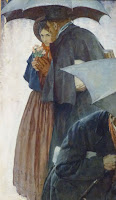The Silkworm 2014)
By Robert Galbraith
(J. K. Rowling)
Mulholland Books, 455
pages.
★★★
By now just about everyone knows that J. K. Rowling writes
detective novels under the pseudonym Robert Galbraith. I figured I might be the
only person on the planet objective enough to review that endeavor. I have
never read a word of Harry Potter, which I originally thought was children's
literature. I now believe those who told me I'm wrong, but by the time I
reconsidered, thousands of pages were in print and I didn't want to invest that
sort of time.
I had no preconceived notion about what sort of writer
Rowling is, but others adore her; the first Galbraith mystery, The Cuckoo's Calling (2013), is never on my library's shelf. From I
can infer from the e-book wait list, I'd not secure the newest, Lethal White, until sometime in the 22nd
century. I only scored The Silkworm because
a hard copy was being reshelfed in front of me.
My verdict? Rowling is very smart and an excellent wordsmith,
but these things don't make her a fabulous mystery writer. The Silkworm is middle-of-the-pack stuff that an agent might have
trouble placing were it not known in the industry that Galbraith was Rowling.
Her private detective (PI) is Cormoran Strike, a tall
thirty-something son of a rock star father he resents, and a former British
solider who lost part of a leg in Afghanistan. A one-legged PI is a challenge,
but he's celebrity in his own right for solving a murder that I gather was the
subject of The Cuckoo's Calling. It's
a standard trope in detective fiction that a PI cracks cases that confound the
police, who then show up as obstacles in subsequent works. Strike's foil/police
contact is a detective named Anstis, with whom he has an on/off
friendship—Anstis sees Strike as a meddler, but owes him his very life. (Strike
saved him from the IUD that took off his leg.) Strike is certainly at a
disadvantage in a city as sprawling as London, and often relies on his
assistant/office manager Robin to do his (ahem!) legwork.
In The Silkworm, Strike is hired by Leonora Quine to locate her
husband, Owen, a half-talented novelist whose books haven't sold well since his
first. Leonora assumes he's shacked up with one of his mistresses, but just
wants him to come home to help care for their brain-damaged daughter, Orlando,
a veritable adult-child. Leonora is blasé about Owen's infidelities, as theirs is
a mismatched marriage—she's a poorly educated working class woman and he an
erudite snob. Strike ultimately finds Quine lying dead in a home he and another
author inherited but have never frequented. Let's just say his demise was gruesome.
To throw a spanner into the works, a new Quine manuscript surfaces, Bombyx Mori ("silkworm") in
which an author is dispatched exactly as Quine was killed.
Was this a staged assisted suicide
from a failed novelist, or a murder? Who would want Quine dead? Pretty much
everyone, given that his final manuscript trashes everyone in the publishing
world under thinly veiled character assassinations such as Vainglorious, Cutter,
Effigy, Harpy, and Phallus Impudicus (a vile-smelling penis-shaped mushroom).
Rowling takes us inside a publishing world that seems more like the imperial
court of 1st century Rome than a bastion of literati. Seven suspects
emerge, including several women said to have slept with Quine, a high-powered
publisher, and Michael Fancourt, a celebrated writer whose vanity surpasses
that of Quine and whose wife committed suicide years earlier when her novel was
critically savaged. Almost everyone is like Quine: pompous, jealous,
name-droppers certain of their own intellectual superiority.
Rowling throws in side stories, a
few that are sops to readers of the previous novel and some designed add character
depth. To me, most were simply diversions that, like the novel's repetition,
begged for an editor. Toss in a few convenient contacts, deductive reasoning,
red herrings, and a diversity tick box (a closeted gay man, a transsexual,
sexism, a mentally challenged secondary figure and a handicapped lead) and
there's a lot going on in the novel. It's hard to keep track of everyone, but
don't worry; Rowling's Strike is basically a coarser Hercule Poirot in disguise.
This novel is updated Agatha Christie—right down to assembling all the suspects
in one place for the reveal.
The Silkworm certainly highlights Rowling's intelligence—not many writers
sprinkle detective fiction with Latin and poetry—but there's a sense in which she
is showing off like many of her characters. She writes exceedingly well, but
she's not capable of liberating herself from standard clichés, plots, and contrivances.
Cormoran Strike has his appeal, but this detective novel is more cold cuts than
hardboiled.
Rob Weir











